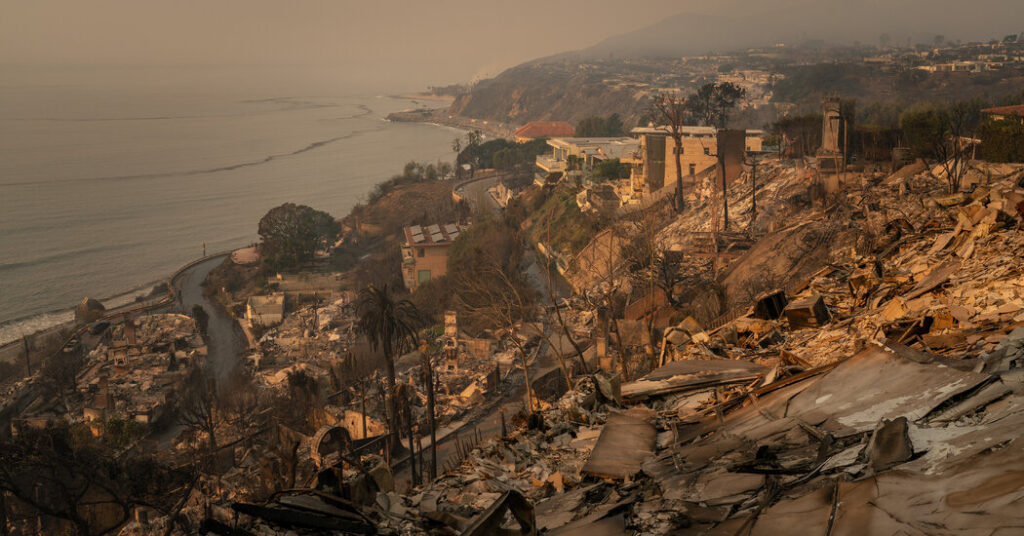As infernos rage through Los Angeles (LA) County, leaving devastation in their wake, residents now face not just rebuilding but navigating a wildfire -induced insurance quagmire. The Los Angeles wildfires have consumed 9,596 hectares (23,713 acres), claimed 27 lives, and razed over 12,300 homes and structures, according to Cal Fire. Analysts predict that insured losses could surpass $20 billion, potentially setting a new record for California. With private insurers retreating from the state, many homeowners wonder: who will foot the bill?

The True Cost of the Fires
Preliminary estimates place the economic impact of the fires between $250 billion and $275 billion, per AccuWeather. This staggering figure not only dwarfs previous wildfires but could make the LA wildfires the most expensive natural disaster in U.S. history, surpassing Hurricane Katrina’s $105 billion insured losses.
To date, the 2018 Camp Fire in Butte County remains California’s costliest wildfire for insurers, with $12.76 billion in losses. But this latest disaster threatens to rewrite the record books.
Read more: Amazon’s $7,999 Fireproof ‘Granny Flat’ Tiny Home: A Game-Changer in Affordable Living
Insurance Companies Retreat Amid Rising Risk
Long before the flames erupted, insurance providers like State Farm and Allstate had already begun exiting fire-prone California. State Farm, once the state’s largest insurer, declined new applications as early as May 2023, citing skyrocketing construction costs, increased catastrophe exposure, and a “challenging reinsurance market.”
Between 2020 and 2022, California saw 2.8 million non-renewals of homeowner policies. Los Angeles alone accounted for over 500,000 of these cancellations. “We’ve seen enormous non-renewals recently,” said Ben Keys, a finance professor at the University of Pennsylvania’s Wharton School. State Farm alone dropped nearly 70% of its policies in Pacific Palisades in 2024.
David Flandro of Howden Re explains the broader implications: “Maybe there isn’t the coverage in place, to cover everyone unfortunately.” Indeed, insurers have struggled under California’s regulatory framework.
Lo & Sons Original Catalina Deluxe Premium Canvas Duffel Bag – Travel, Gym, Hospital, or Weekender Bag with Shoe Compartment for Men and Women
Regulatory Challenges and Proposition 103
California’s Proposition 103, passed in 1988, capped insurance rates and mandated prior approval from the state’s Insurance Commissioner for adjustments. This cumbersome system has seen approval delays swell from 157 days (2013-2019 average) to 293 days (2020-2022). Insurers argue that this limits their ability to factor in modern climate risks, such as increasing wildfire severity and frequency.
Ray Lehmann of the International Center for Law and Economics explains, “Proposition 103 … has not permitted insurers to consider the impact of climate change, or that future losses may be much more significant than past losses.” Between 2004 and 2023, average annual structure losses in California increased nearly tenfold, underscoring the insurers’ frustration.
Limited Options for Homeowners
With traditional insurance out of reach, many homeowners turn to California’s FAIR Plan, a state-mandated last-resort insurance. Funded by private insurers, this plan offers basic coverage—up to $3 million. But for many in high-cost areas, this falls far short. Worse yet, it costs an average of $3,200 annually, more than double California’s standard $1,480 average for home insurance on a $300,000 dwelling.
Currently, over 450,000 Californians rely on the FAIR Plan, and its exposure has skyrocketed. From September 2023 to September 2024, the plan’s liabilities surged by 61.3%, reaching $458 billion. Yet, high deductibles and limited coverage leave homeowners vulnerable.
Climate Change Fuels Uncertainty
California’s “fire season” has now become a year-round threat. Governor Gavin Newsom remarked, “It’s year-round in the state of California.” Climate change has not only extended fire seasons but amplified their severity. Between 2014 and 2023, wildfires destroyed 5,669 structures annually on average, a drastic rise from the previous decade’s 653 annual average.
Insurance experts warn that the industry is underprepared for climate-driven risks. Research by Insure Our Future found climate change responsible for a third of global weather-related insurance losses over the past 20 years. To “ensure that California remains insurable,” Lehmann suggests mitigating wildfire risk through stricter building codes, underground power lines, and strategic zoning changes.
Is the System at Risk?
Despite the enormous losses, most experts believe California’s insurers can absorb the blow. “Insurers writing homeowners insurance in California are financially strong,” assures Lehmann. JPMorgan analysts agree, projecting most claims will impact homeowners’ policies rather than commercial or auto insurance lines.
However, affluent neighborhoods hit hard by the fires may strain insurers. The Palisades Fire disproportionately damaged high-value properties, where high-net-worth individuals often carry more expensive coverage.
Looking Ahead: Can California Adapt?
The Los Angeles wildfires underscore the precarious intersection of climate change and economic resilience. Without significant policy reforms, including streamlined insurance regulation and proactive wildfire mitigation, California risks losing its insurability. Homeowners must remain vigilant, explore alternative insurance options, and demand legislative action to adapt to this “new normal.”
For those impacted, rebuilding is not just a physical endeavor but an economic one. Whether through FAIR, private insurers, or state initiatives, Californians need a robust safety net to protect against the inevitability of future fires.


